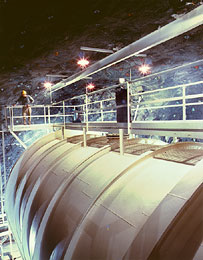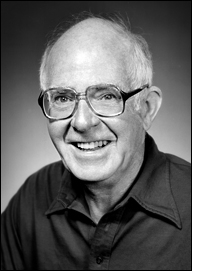Solar Neutrinos
A neutrino (an Italian word meaning "little neutral one") is a very small sub-atomic particle that is produced in several types of nuclear reactions. Its existence was first hypothesised in 1930 by Wolfgang Pauli to explain how energy might be conserved in a form of radioactivity in which beta particles (high speed electrons) are given off. However, the first neutrino was not detected until 1956 by Fred Reines and Clyde Cowan using a detector placed near a nuclear reactor.
The properties of a neutrino are very strange. It has no charge, and for a long time was thought to have no rest mass. So it has only a very small amount of energy and a quantum mechanical spin. With these properties, a neutrino has very little interaction with other matter, and neutrinos can pass right through the Earth in a few milliseconds. This makes them very difficult to detect. However, in 1946, Bruno Pontecorvo discovered a reaction in which a neutrino colliding with a chlorine atom could change it into a radioactive argon atom. A radiation sensor could then detect the decay of this argon atom. Interestingly the US Atomic Energy Commission classified this discovery in case the Russians used it to detect nuclear submarines. Luis Alvarez had to rediscover it in 1949.

Raymond Davis Jr used this reaction to first detect and then to accurately count neutrinos emitted from the core of the Sun where thermonuclear reactions occur. His experiments involved a 400,000 litre tank of dry cleaning fluid (perchloroethylene) containing lots of chlorine atoms that he located 1.5 km below the Earth's surface in the Homestake Gold Mine in South Dakota, USA. It was placed deep underground to protect the detectors from cosmic rays. The only problem with the results found in this experiment was that it detected only about one third of the solar neutrinos that theoretical models predicted. Scientists around the world then built other neutrino detectors: Kamiokande in Japan, SAGE in the Soviet Union, GALLEX in Italy and Super-Kamiokande. All of these experiments are massive and require extreme precision.
All of the detectors showed what appeared to be a deficit of neutrinos coming from the Sun. This was a big problem. Did it mean that the nuclear reactor at the core of the Sun had shut down? This was not something that astrophysicists really wanted to believe, as it would have enormous ramifications for life on Earth in the future. Further confounding the issue was the detection of a burst of neutrinos from a supernova in the Large Magellenic Cloud in February 1987 where the number of neutrinos detected was exactly what astrophysical theory predicted.
Finally, in 2001, scientists at the Sudbury Neutrino Observatory in Canada reported the detection of three different types of neutrinos from radioactive decays involving electrons, muons and tau leptons respectively. Earlier detectors could not detect all three types of neutrinos, and it is now believed that neutrinos change from one type to another in the 8 minute journey from the Sun to the Earth. This oscillation implies that neutrinos do have mass, albeit vanishingly small. A detector that is sensitive only to the neutrino type produced in the solar core, will record less neutrinos than expected, because about 70% have changed type.

Raymond Davis was awarded the Nobel Prize for his solar neutrino work in 2002, and died in May 2006 at the age of 91.
Material prepared by John Kennewell and Andrew McDonald





